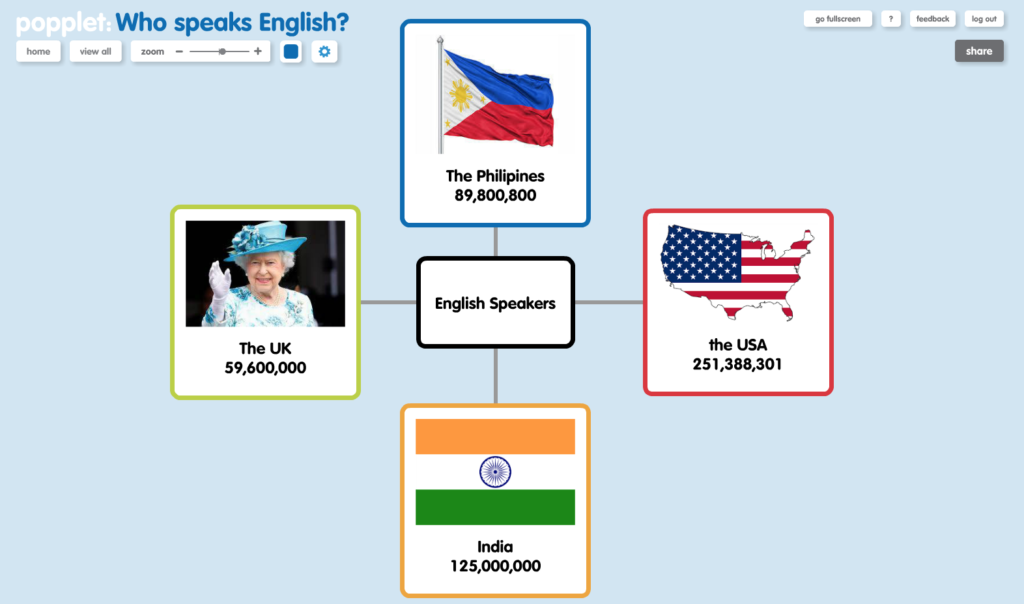Popplet is a favorite tool of literacy teachers, especially those who work with younger learners. Reading, writing, spelling, and the other key elements that children need to solve the language puzzle are particularly significant in the early years since this early progress has a universal impact on their development. The methods they use closely resemble some of those employed by language teachers.

Phonics, or one of its variants, is the method most used by school teachers to teach children how to read. In English language instruction, we combine phonics and phonetics, along with other linguistic concepts and label this key area of English language tuition, Pronunciation.
First steps with Popplet and Pronunciation – a lesson
- A brief presentation about English pronunciation, with constant student feedback.
- Students carry out research related to the lesson and create popplets to show their results.
- Class discussion.
I like to introduce Popplet and pronunciation at the same time in my classes. There is no increase in difficulty, since, like any good tool, Popplet adds value to the student’s experience. More significantly, visualizing their experiences by creating a Popplet board about what they learn, enhances their learning and leaves them a visual record for revision.
All of your students will know about pronunciation. Some will have seen IPA symbols before, a few might understand them. Others will groan at the prospect a subject that has not been highly regarded these last years and may even resist. The majority, however, will be curious the moment you write Pronunciation on the board, and that is always the best place to begin a class.
Lesson
Explain to the students that they are going to learn about pronunciation, and explain to them why it is important for them to study it, answering any questions that arise.
- Begin by talking about the different types of English that exist, explain how they vary and why the often used term Standard English may forever be an elusive concept. Be sure to mention which dialect you belong to, or favor.
- Then, Illustrate with some popular examples:
British vs American English’s legendary “tomahto” /təˈmɑːtəʊ/, “tomayto” /təˈmeɪtoʊ/, or
How the Canadian pronunciation of “about” /əˈbaʊt/, “aboot” tickles their US neighbors
- Focus on UK Received Pronunciation (RP), the language of the Queen of England, her family, and a few other people in the world. Highlight some of the ways it differs from Scottish English or American English, for example.
- Amaze your students by explaining that words like car /ka:/. chair /’tʃeə/, and where /’weə/ are maybe not pronounced as they might imagine. If they don’t believe you, provide more examples.
- Introduce the class to the schwa /ə/, and reveal why this particular sound is so popular with English speakers by modeling the words chocolate /’tʃɒkələt/ and vegetable /’vedʒtəbl/. Introduce sentence stress.
- Finally, at the risk of overwhelming your students with what they will have come to believe is the entirely illogical nature of the English language, bring up words that contain silent letters such as know /nəʊ/, walk /wɔ:k/ and talk /tɔ:k/.
Popplet Activities & Discussion
- Research the countries where English is spoken worldwide. How many people speak English as a first language or second language? Contrast the results with other widely spoken languages like Mandarin or Spanish, Create a Popplet containing your results and add appropriate images such as charts or geographical identifiers -flags! Different groups or students could do the different languages.

- Research the countries/places in the world where Engish is the first language or widely spoken. Which countries have the most English speakers? Create a Popplet with your results and add appropriate images.
- Collate results, displaying the best popplets for the whole class to see, using the results to initiate a class discussion on what English pronunciation might sound like fifty years from now.
If your students can access the internet on their devices in class, they can do this activity there and then. If not, set this as a homework exercise. If set as a group exercise, students can collaborate on their work.
Students will very quickly get the hang of Popplet.if they appear hesitant or have any questions direct them to the slideshow demo, which can be accessed by clicking on try it out on the Popplet home page. In no time at all ,students will be eagerly creating impressive visuals. Avoid lecturing on the use of Popplet, let the students discover what it can do.
By the end of the lesson, the class will be well versed in the basics of Pronunciation and Popplet creation. They will want to know more.
Popplet is available on the web, and new users receive five popplet boards for when they sign up for a free account. If you find you need more than five popplet boards, you can simply delete existing ones, or you can sign up for the full version of Popplet at the iTunes store. There is a free version of the iPad app: Popplet Lite, also available from the iTunes Store. School and Class group subscriptions are also available.
If you find this idea useful, or if you are already using Popplet in your ESL classes then please let us know by sharing your ideas with the Popplet community on Twitter, and our Facebook page. To sign up for a free account, visit the Popplet home page.